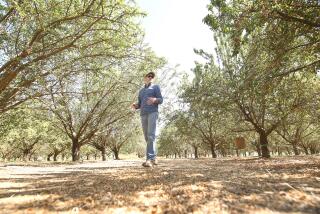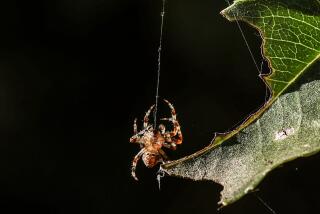Web of Intrigue : Tiny Insects Take California Scientist on a Lifelong Safari
SAN RAFAEL, Calif. — The trek was arduous, the life style spartan.
The first of many expeditions Edward S. Ross led in search of some of Africa’s smallest game began in the late 1950s at the lower mouth of the Congo River, extended to Mombasa, zig-zagged south to the Cape of Good Hope and ended in Angola.
For 325 days the expedition, led by the Mill Valley scientist, camped in isolated deserts, took sponge baths in water boiled over a camp stove and slept atop a truck. The climate was steamy. The diet was rice, fruits and vegetables.
What might seem a nightmare to some was “the exhilaration of being” to Ross, a world-renowned entomologist.
Ross, 71, who says he “can’t imagine anyone with all their marbles not wanting to do this sort of thing,” has been crisscrossing continents for almost 50 years, chasing a silk-spinning insect known as embiidina.
The insects, commonly referred to as “web-spinners,” spend most of their lives in labyrinths of silk covering the bark of trees or hidden underground. The webs spin from hundreds of glands in their front feet.
Wings Roll Up
During the spinning process, the embiidina appears to be shadowboxing as it slowly ejects one silken strand per gland. If a predator is encountered, the insect can run backward. If its wings get in the way, it can roll them up.
“If we could adapt this technique, a pilot could roll up the wings of his airplane and drive it into a garage,” Ross once joked.
During 30 expeditions in every corner of the world except Alaska and Antarctica--where it’s too cold for embiidina to live--Ross has collected more than 300,000 specimens representing more than 1,000 species of the insect. He thinks there may be 2,000 to 3,000 undiscovered species.
The lifelong work of Ross, curator emeritus of entomology at the California Academy of Sciences in San Francisco’s Golden Gate Park, is the focus of an exhibit sponsored by the academy entitled “Lifelong Safari.”
Ross began his safari near his childhood home in San Francisco in the 1920s. He likes to say he was “born in the bush,” roaming the hills and meadows for days.
Those forays laid the foundation for a passion that has consumed his life. By the time he left for college he had mounted, labeled and classified more than 50,000 beetles.
And Ross isn’t finished. He is considering an expedition taking him into the mountains of North Vietnam.
Rare Web-Spinner
There in 1916, in the old French hill station of Cha Pa, a Jesuit priest mounted a specimen of a rare web-spinner called Embonycha interrupta. Ross wants to find his own specimen.
His love of the web-spinners began in graduate school and continued through World War II, when he headed a malaria survey in the South Pacific and along the way collected about 80,000 insect specimens.
One of his first excursions, in 1936, was a field trip to southeastern Arizona with only $30 in his pocket. In 1938 Ross and two companions drove 2,000 miles to Baja California in a panel truck.
For eight months in 1950-51, Ross toured Chile, Argentina, Bolivia and Peru. By 1953 he had developed his technique for “bringing the camera to the insect,” which led to a book entitled “Insects Close Up.”
In 1961 he created the ultimate “dream truck” for a yearlong excursion across Asia and later several excursions to Africa. The vehicle had a range of 500 miles and was designed so its roof served as a campsite.
May Be World’s Oldest
Ross believes that the web-spinners are among the world’s oldest insects, evolving hundreds of million of years ago when the globe’s present-day continents were joined into one large land mass called Pagaea.
Over the ages Pagaea fragmented. On each land mass was a band of embiidina, Ross said in a recent issue of Pacific Discovery, an Academy of Sciences magazine.
Little is known about the obscure habits of embiidina because they are seldom collected, he said.
“Uncovering knowledge about them is to me what an unmapped continent would be to an explorer.”
More to Read
Sign up for Essential California
The most important California stories and recommendations in your inbox every morning.
You may occasionally receive promotional content from the Los Angeles Times.










